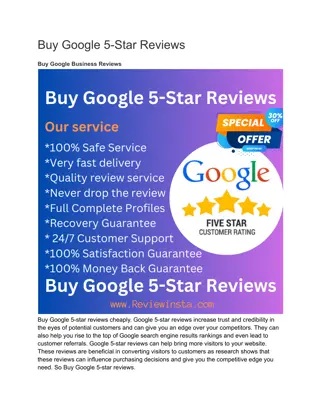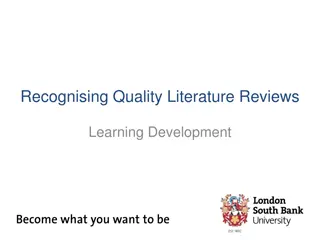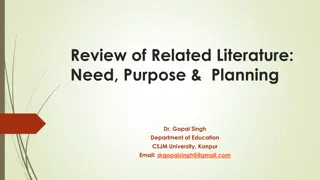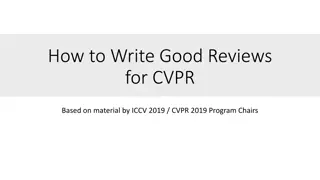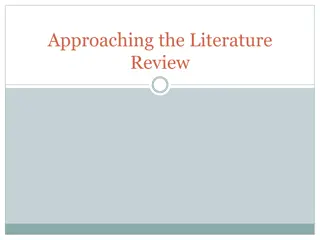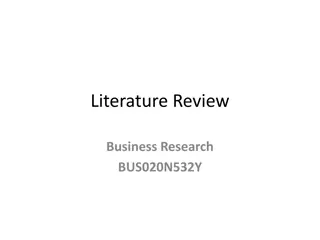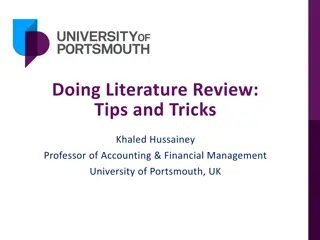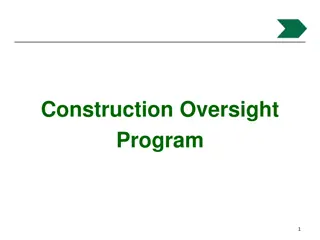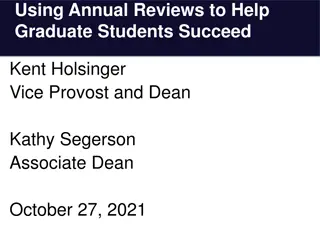LITERATURE REVIEWS
In a legal thesis, literature reviews play a crucial role in analyzing existing research, contextualizing the study, and developing arguments. This overview covers the technical advice, differing opinions on approaches, and the importance of starting with legal principles before exploring literature. It emphasizes the need for a broad approach to incorporate various perspectives and critique the literature effectively. Learn about the purpose, structure, and significance of literature reviews in the legal domain.
Uploaded on Mar 02, 2025 | 0 Views
Download Presentation

Please find below an Image/Link to download the presentation.
The content on the website is provided AS IS for your information and personal use only. It may not be sold, licensed, or shared on other websites without obtaining consent from the author.If you encounter any issues during the download, it is possible that the publisher has removed the file from their server.
You are allowed to download the files provided on this website for personal or commercial use, subject to the condition that they are used lawfully. All files are the property of their respective owners.
The content on the website is provided AS IS for your information and personal use only. It may not be sold, licensed, or shared on other websites without obtaining consent from the author.
E N D
Presentation Transcript
LITERATURE REVIEWS Caroline Goodier & Ann Strode School of Law, UKZN
OVERVIEW Background - Literature reviews for a legal thesis Technical advice on literature reviews: What is a literature review? Why do a literature review? How to undertake a literature review? Example literature review on self testing for HIV by or with children
LEGAL LITERATURE REVIEWS Not a traditional legal approach Entire thesis is based on a discussion on laws, cases, academic and other opinions as found in the literature Differing opinions on the format of a legal literature reviews: Narrow approach look at literature/views on the primary sources of law Broader approach look at laws, cases, policy documents, international obligations, academic and grey literature
Recommend the broad approach in which the legal principles are set out and then the literature from various perspectives is described and critiqued If use this approach can t start without setting out the law/basic legal principles on the issue before moving to the literature
WHAT IS A LITERATURE REVIEW? A literature review is an informed assessment of the existing research on the topic under study (Vithal & Jansen, 2010, p. 16) A review of the existing scholarship or available body of knowledge to see how other scholars have investigated the problem you are interested in
It is not just a list of references It is a critical and persuasive account of existing research Joining a debate on a particular subject (Given. 2008) Contextualising your work It both: Describes e Describes existing work Analyses it Analyses it (Walliman, 2006)
WHY DO A LITERATURE REVIEW? Situate your study in the literature by identifying a knowledge gap Provide supporting evidence of a problem/issue addressed by your research and in this way show its importance Explain or unpack your use of concepts and introduce relevant terminology/provide definitions Develop an argument for what is in the literature and how it relates to your study and identify gaps Show counter-arguments Identify key trends/themes
In other words the literature review In other words the literature review is is where where you discuss how your you discuss how your research research emerges from emerges from and on previous on previous research . research . and builds builds
HOW TO UNDERTAKE A LITERATURE REVIEW? Example: Offering self HIV tests Example: Offering self HIV tests to children to children is it lawful? is it lawful? Buy an HIV test off the internet for R 100 From December 2013 pharmacies may sell HIV home tests withoutr any specific restrictions
Self HIV testing a test done without the involvement of a third party rapid test Home/any other private place No law/policy on when or who should have access to self- testing Explore self-HIV testing for children article: Is there any legal restriction on a child buying a self-test? At what age could a child use a self test? Would they have to be counselled first? Is it in their best interests to use this form of testing? Started with a literature review
STEP ONE: DEFINING THE BOUNDARIES Conceptualising the parameters of Conceptualising the parameters of the literature search the literature search Example Example (a) Identify the broad area of law that you will be investigating Medical law HIV testing with children
Undertake provisional reading to Undertake provisional reading to get a sense of the area of law get a sense of the area of law Example Example Children s Act sets out the 4 key norms for HIV testing with persons under the age of 18: Testing must be in the best interests of the child Independent consent from 12 All testing accompanied by counselling All test results are confidential (b) Read the key statute, case in point, textbooks or LAWSA Give an overview of the area of law Identify some of the key issues Refer to key authors in the field
Decide what type of Decide what type of literature will be reviewed literature will be reviewed Example Example (c) Decide what type of literature you will be searching through Eg: Constitution Statutes Common law Cases Policy documents Green Papers, policies of government departments etc Journals Papers by NGOs etc Law on HIV testing in Law on HIV testing in SA SA Academic opinion on Academic opinion on self self- -HIV testing of HIV testing of children in SA children in SA National/international National/international studies studies Published/unpublished Published/unpublished studies 1990 studies 1990 2013 2013
STEP TWO: GATHERING THE INFORMATION Identify the methodology for your Identify the methodology for your search and collect the information search and collect the information Example Example Key words: Key words: HIV, self HIV, self- -test; child; HIV, self test; child; HIV, self- - test, child, psychosocial; HIV, test, child, psychosocial; HIV, self self- -test, child, legal; HIV, test, child, legal; HIV, self self- -test, child, ethic; HIV, test, child, ethic; HIV, self self- -test, feasibility; HIV, test, feasibility; HIV, self self- -test, acceptability; and test, acceptability; and HIV, home test; HIV, home HIV, home test; HIV, home test, child; HIV, home test, test, child; HIV, home test, child, psychosocial; HIV, child, psychosocial; HIV, home test, child, legal; HIV, home test, child, legal; HIV, home test, child, ethic; HIV, home test, child, ethic; HIV, home test, feasibility and home test, feasibility and HIV, home test, acceptability HIV, home test, acceptability Use the parameters of the review as a guide Identify the databases etc that will be used List your key search terms Undertake the search
Some sound advice from Rose Kuhn: A literature search usually starts off in quite a linear manner, often becoming circular and steps may be repeated Don t underestimate the value of serendipitous findings Online searching will probably yield different results at different times due to constant updating It s a good idea to re-run searches at different times
EBSCOhost web, MedLine, PubMed and PsycINFO & Google Found nothing on children 152 studies on self-testing 28 articles met the inclusion criteria
STEP THREE: READ AND SUMMARISE Read and summarise the articles that you have collected Skim read articles or study abstracts and collect literature, then read it and sift through the content once you have a pile of references Make notes/summaries as you move through the literature Try to collect information around key emerging themes Key themes: A number of international policy statements on self- testing - norms Challenges, eg, how to link the tester to CD4 cell counts and treatment/suicide risk User-feed back instructions were clear
STEP FOUR: SELECT KEY ASPECTS FOR THE WRITE UP Select the key issues from Select the key issues from the review the review Not all the information is relevant Go back to your key questions to narrow done the findings Started to identify themes and made a working document with sub headings and then added each author s point on that issue in that document
STEP FIVE: ANALYSE AND EVALUATE INFORMATION Review the sections you have selected Review the sections you have selected and analyse/evaluate them and analyse/evaluate them Example Example Privacy Literature stated that a key benefit of self-testing is that it is confidential (Ng, Chow et al, 2013) Comment made - suitable to environments where there is lots of stigma and discrimination Review all summaries and identify: What Information exists on the issues that you were researching? Ie what is known? Identifying key themes that emerge from the literature
Set out the law Describe the literature on the law Analysing providing your own opinion: Strengths what is known? Weaknesses what is not known? Gaps? Contradictions? Inconsistencies? Make connections between one reference and another and explicit links between these sources and your own work. Take the argument and think of it as a dialogue. Respond to the other voice
STEP SIX: WRITE UP THE LITERATURE REVIEW Write up Example Example Write up a formal literature review Use this in your proposal/thesis Article
Use this information to justify your approach/study Our literature review showed that there was no information, no studies and no policy positions on whether it would be appropriate or even legal to offer self-testing to chi9ldren Article examined when and how self-testing with children would be lawful concluded: Over the age of 12 recommended 16 and above Counselling via telephone/web application
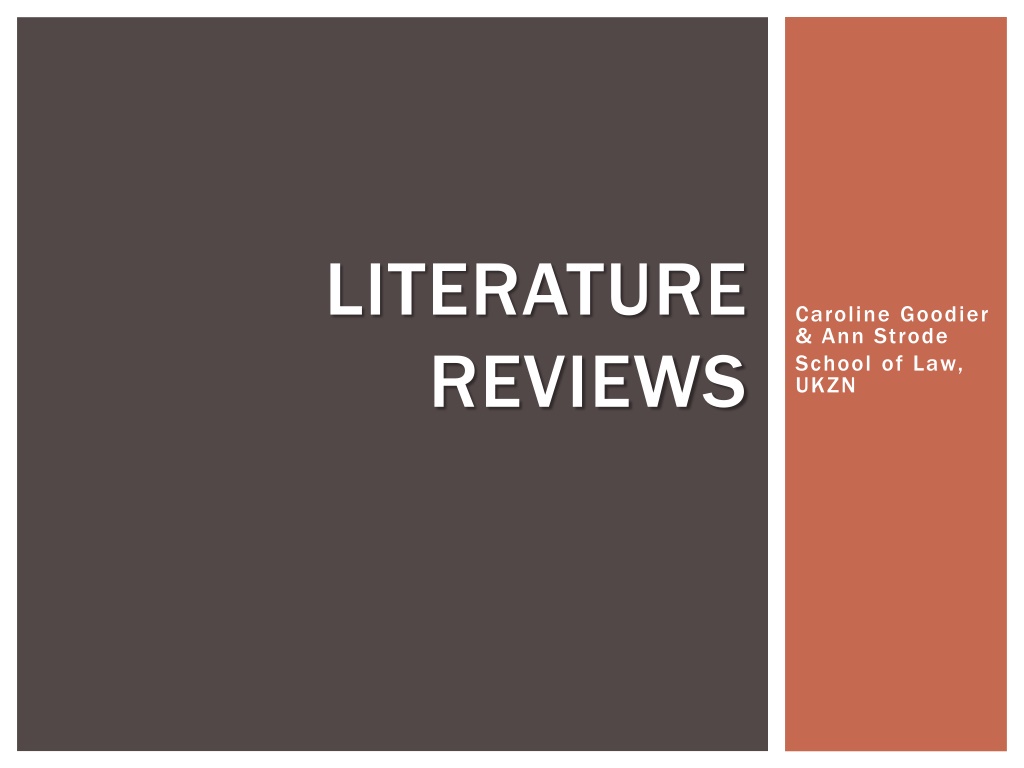
 undefined
undefined




